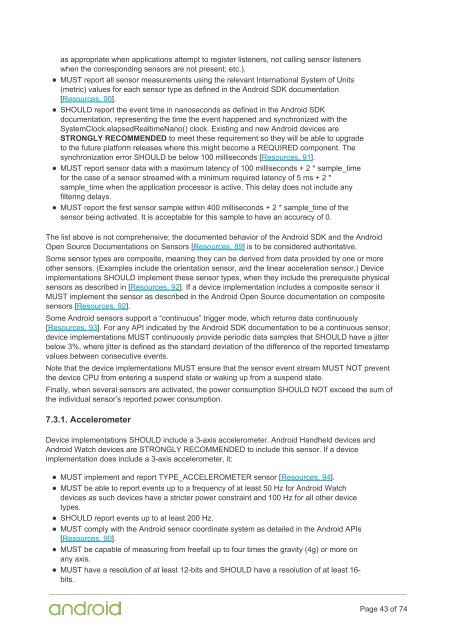Compatibility Definition
2f44OdUf0
2f44OdUf0
You also want an ePaper? Increase the reach of your titles
YUMPU automatically turns print PDFs into web optimized ePapers that Google loves.
as appropriate when applications attempt to register listeners, not calling sensor listeners<br />
when the corresponding sensors are not present; etc.).<br />
MUST report all sensor measurements using the relevant International System of Units<br />
(metric) values for each sensor type as defined in the Android SDK documentation<br />
[Resources, 90].<br />
SHOULD report the event time in nanoseconds as defined in the Android SDK<br />
documentation, representing the time the event happened and synchronized with the<br />
SystemClock.elapsedRealtimeNano() clock. Existing and new Android devices are<br />
STRONGLY RECOMMENDED to meet these requirement so they will be able to upgrade<br />
to the future platform releases where this might become a REQUIRED component. The<br />
synchronization error SHOULD be below 100 milliseconds [Resources, 91].<br />
MUST report sensor data with a maximum latency of 100 milliseconds + 2 * sample_time<br />
for the case of a sensor streamed with a minimum required latency of 5 ms + 2 *<br />
sample_time when the application processor is active. This delay does not include any<br />
filtering delays.<br />
MUST report the first sensor sample within 400 milliseconds + 2 * sample_time of the<br />
sensor being activated. It is acceptable for this sample to have an accuracy of 0.<br />
The list above is not comprehensive; the documented behavior of the Android SDK and the Android<br />
Open Source Documentations on Sensors [Resources, 89] is to be considered authoritative.<br />
Some sensor types are composite, meaning they can be derived from data provided by one or more<br />
other sensors. (Examples include the orientation sensor, and the linear acceleration sensor.) Device<br />
implementations SHOULD implement these sensor types, when they include the prerequisite physical<br />
sensors as described in [Resources, 92]. If a device implementation includes a composite sensor it<br />
MUST implement the sensor as described in the Android Open Source documentation on composite<br />
sensors [Resources, 92].<br />
Some Android sensors support a “continuous” trigger mode, which returns data continuously<br />
[Resources, 93]. For any API indicated by the Android SDK documentation to be a continuous sensor,<br />
device implementations MUST continuously provide periodic data samples that SHOULD have a jitter<br />
below 3%, where jitter is defined as the standard deviation of the difference of the reported timestamp<br />
values between consecutive events.<br />
Note that the device implementations MUST ensure that the sensor event stream MUST NOT prevent<br />
the device CPU from entering a suspend state or waking up from a suspend state.<br />
Finally, when several sensors are activated, the power consumption SHOULD NOT exceed the sum of<br />
the individual sensor’s reported power consumption.<br />
7.3.1. Accelerometer<br />
Device implementations SHOULD include a 3-axis accelerometer. Android Handheld devices and<br />
Android Watch devices are STRONGLY RECOMMENDED to include this sensor. If a device<br />
implementation does include a 3-axis accelerometer, it:<br />
MUST implement and report TYPE_ACCELEROMETER sensor [Resources, 94].<br />
MUST be able to report events up to a frequency of at least 50 Hz for Android Watch<br />
devices as such devices have a stricter power constraint and 100 Hz for all other device<br />
types.<br />
SHOULD report events up to at least 200 Hz.<br />
MUST comply with the Android sensor coordinate system as detailed in the Android APIs<br />
[Resources, 90].<br />
MUST be capable of measuring from freefall up to four times the gravity (4g) or more on<br />
any axis.<br />
MUST have a resolution of at least 12-bits and SHOULD have a resolution of at least 16-<br />
bits.<br />
Page 43 of 74


